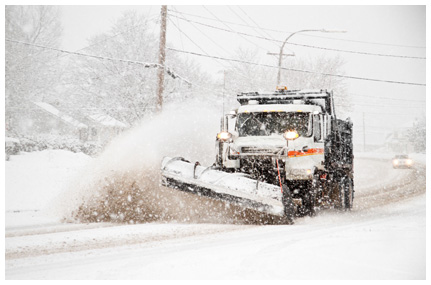Wintry weather unlikely to chill materials price increases; LNG, hotel markets advance Editor’s note: Construction Citizen is proud to partner with AGC America to bring you AGC Chief Economist Ken Simonson's Data DIGest. Check back each week to get Ken's expert analysis of what's happening in our industry.
Editor’s note: Construction Citizen is proud to partner with AGC America to bring you AGC Chief Economist Ken Simonson's Data DIGest. Check back each week to get Ken's expert analysis of what's happening in our industry.
The widespread extreme weather this winter is likely to distort construction spending and employment data for several months but not change longer-term trends. “As one industry contact noted, just because it snows on a Saturday doesn’t mean that by Tuesday when the weather clears you don’t want to buy carpet,” Thompson Research Group (TRG) wrote last Monday in its monthly building products survey. “A contact with whom we met at the International Builder’s Show in Las Vegas last week noted that there has been meaningful improvement in terms of working in adverse weather conditions over the past 10 years (i.e., able to pour concrete in colder weather, etc.). Regardless, it will take several months to have an accurate read on lost vs. deferred volumes. [W]e are focused on how a weak start to 2014 could impact [building products] pricing resolve in 2014. [In January,] Raw steel pricing continued to rise. [Wallboard pricing was] up sequentially due to the 20% price increase in 2014—expect 12-15% realization. [Insulation pricing was] flat to up. [For roofing materials, an] April mid-single digit price increase announced. [Flooring pricing was] flattish sequentially; expectation for spring soft flooring increase. [For ceiling tile, a] 4% price increase announced for February/March, and all respondents expected this increase to go through. [Lighting sales were] flattish sequentially and LED pricing continues to push lower.”
The market for natural gas export facilities continues to grow. Last Tuesday, Sempra Energy reported that the Department of Energy (DoE) conditionally authorized its subsidiary “Cameron LNG to export domestically produced liquefied natural gas (LNG) from its proposed liquefaction facilities in Hackberry, La.” The Associated Press reported, “Approval is still needed from the Federal Energy Regulatory Commission, company spokesman J.C. Thomas in San Diego said Tuesday… .Sempra wants to add liquification plants and other facilities to turn the import terminal into an export terminal. The expansion would cost up to $10 billion, with up to $7 billion of it in capital construction costs… .The Energy Department has now approved six LNG export projects—three in southwest Louisiana, two in Freeport, Texas, and one in Maryland—with applications pending for another 20, according to the American Petroleum Institute. Those still in line include eight in Louisiana, six in Texas, two in Oregon, one each in Georgia and Mississippi, and two in the Gulf of Mexico—one south of Cameron Parish and the other south of Pascagoula, Miss., and east of the Mississippi River’s mouth. Experts agree that not all will be built, said Eric Milito, upstream director for the American Petroleum Institute. The six projects approved so far by DoE and another 20 that have applied could produce a total of 25 to 35 [billion cubic feet] per day, but proposed projects outside the United States would total nearly 100 billion cubic feet per day, Milito said. The department should act quickly on remaining applications, he said. ‘Every day puts the United States further behind when it comes to competing in a global market.’”
Recent hotel sales “are helping drive the average sales price to new highs,” the Wall Street Journal reported on Wednesday; that could trigger additional construction. “Until now, hotel values have been rising partly because there has been scant new supply. But for some of the hottest hotel markets, that is about to change. In seven major metro areas—including New Orleans, Houston, Seattle and Los Angeles—the number of rooms under construction has at least doubled over the past year, according to Smith Travel Research.”
The Dodge Momentum Index rose 3.0% from December to January, McGraw Hill Construction reported on February 7. The index is “a monthly measure of the first (or initial) report for nonresidential building projects in planning, which have been shown to lead construction spending for nonresidential buildings by a full year.” The rise “was driven by strength for its commercial building segment [especially office and hotel development], while plans for institutional building held steady.”
A report Friday from TRG on “revenue collections from our core 14 states which comprise the majority of revenues for some of our coverage universe” contains modestly favorable news for state funds potentially available for construction. “General Fund (GF) tax collections for our core 14 states in H1’14 [July-December 2013, the first half of fiscal 2014 for most states] increased 7.7% YOY [year-over-year], and are up 21.6% from the recession lows in 2010. GF collections have shown YOY increases in 15 of the past 16 quarters [and] are at an all-time high on our records back to January ‘06. Fuel tax collections for our core 14 states in H1’14 increased 3.6% YOY, and up 7.2% from the 2010 lows. Fuel tax collections have shown YOY increases in 12 of the past 15 quarters [and] are at a multi-year high (Jan ‘08). State revenue collections continued to recover in all major categories. Increased payrolls (up in 13 of our core 14 states), an improving stock market, and rising home values drove General Fund, Sales, Income, and Fuel tax collections. Corporate tax collections continue to struggle with only half of our states seeing YOY improvement.” Combined state and local construction spending rose slightly YOY (1.6% or less) in August through December after 12 straight YOY declines, according to an AGC analysis of Census Bureau data.
The Data DIGest is a weekly summary of economic news; items most relevant to construction are in italics. All rights reserved. Sign up at www.agc.org/datadigest.
AGC's Data DIGest: February 10-14, 2014
by Ken Simonson | February 17, 2014



Add new comment